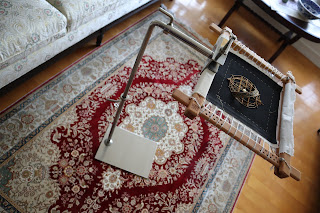It's finally that time! I'm finally stitching the goldwork piece I've been
eyeing for over a year. I stitched the first piece in January 2021, I had to look it up because it feels like longer.
Cynthia really worked hard to get us to this design ready for us. And believe
me we nagged her the entire way lol.
An Astrolabe is made up of many parts: the Alidade, Mater, Latitude plates (plural as a user could have many),
Rete and Rule. Cynthia's Astrolabe is made up of 3 pieces: the Alidade, the
Rete, and the Mater and plate making up one layer. There is no Rule. I've
always been fascinated by this tool and will look forward to learning more
about it.
The materials came in two shipments due to manufacturing delays. And there are
a lot of them. There are eight lessons total with one lesson dropped a week.
Cynthia estimates each lesson requiring 10 hours of stitching. We'll see if
that's true. Lessons 1, 2 and 3 cover the Rete.

|

|
In the past, the fabric comes with the design pre-printed on the cotton
fabric. This time due to the size of the design, Cynthia couldn't print the
design for us on her printer. I used a blue chalk pencil and a window to do
the transfer. I was too lazy to pull out my light pad.
Lesson 1 involves the overlapping cross at the center of the Rete. It's made
up of five rounds and it got really tight as we got to the last round.
It's okay if we went over the blue outline as long as the shape looks nice
(the fabric is going to get cut out later) but I did have to go back and
trim the first layer of purl pearl in order to put in the last layer of purl
pearl.
A picture just because it's so pretty. Fun fact, Cynthia crimped that plate
for us using her crimper. Here's a
link for you to see what it looks like.
The last part of lesson 1 is filling this pretty tear drop with chipping.
In lesson 2 we stitch the circle that goes around the cross.
And it involved a lot of cutwork. A lot of it! I did it over a period of two
days. Alternating between stitching and cutting. They all had to be a
specific size in order to cover the string padding and stitched at an angle.
All I can say is it took a long time and thank God for my time spent doing
Japanese embroidery. I found that it really helped me in putting in the purl
without losing my angle. It's basically a stripped cord. The trick is you always want to come out farther
away from the previous stitch than you expect and go in right next to where
the previous stitch ends. This helps you keep your angle.
Another thing I'm thankful for is this
Lowery stand. My
sisters got this for me on my birthday with this project in mind. I love it!
It made stitching this project both easier and less painful. Using the
clamp, I could easily rotate my frame as I went around the circle and I
could quickly spot if I lost my angle.
Another picture just because. That black purl looks like velvet, so pretty
against the gold.
The final step is to couch purl pearl all around the circle of cutwork. This
really completes it and hides the edge of the cutwork. So if you have one or
two that were a little short, it's okay you won't be able to see it.
I'm half-way through lesson 3. I missed a weekend to go help out
L'Atelier de Penelope. She had a booth at the
Cercles de Fermières du Québec provincial seminar in Saint-Hyacinthe. You can read more about it on my Facebook page. So I'm spending today catching up and hopefully will be done in time for lesson 4 when it drops tomorrow.























